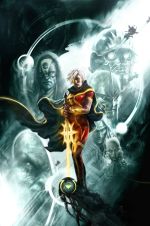Annihilation Conquest: Nova #4
Writers: Dan Abnett & Andy Lanning
Art: Sean chen & Scott Hanna / Brian Denham
Annihilation Conquest: Wraith #1
Writer: Javier Grillo-Marxuach
Art: Kyle Hotz
Annihilation Conquest: Quasar #1
Writer: Christos Gage
Art:Mike Lily
Annihilation Conquest: Starlord #1
Writer: Keith Giffen
Art: Timothy Green II
Having kicked off a truly cataclysmic crisis in Annihilation Conquest Prologue, these four series pick up the threads that were left at the end of it: We catch up with Quasar and Nova, find out how Quill survives and meet an enigmatic new player.

Nova picks up around the point the energy wave explodes from Hala that removes the galaxy out of sync, at the same time he is being attacked by Kree sentries and the Worldmind becomes subject to attempted assimilation by the Phalanx. Were that all he had to contend with he would probably be fine, but the Phalanx are using Gamora to co-ordinate the assault upon him from afar. Nova is told there is a Babel spire on Hala that’s crucial to the Phalanx’s operation, he sees it but is unable to get close. Instead he is forced to retreat by use of a stargate, yet not even this can get past the barrier erected by the Phalanx. He exits hyperspace and just avoids smashing into it but crash lands on a planet, critically injured. Found by dwellers on that planet, Nova transfers his ability to her…
Wraith’s opener begins with a ship being intercepted by the Phalanx, they encounter unexpected resistance. Wraith fights his way out and heads for the nearest Kree planet, there he seeks contact with the resistance but the Phalanx find the base and capture him. Later an interrogator is sent to question him, the interrogator is Ronan…
Meanwhile Quasar is seeking the mysterious figure she has been told is the Redeemer, though for who or what manner of redemption remains unclear. She goes to the Priests of Pama for guidance but the Phalanx have sent the Super-Adaptoid after her: In the course of the battle she becomes enraged and the quantum bands darken. With the priests help they locate a beacon for what she is seeking, but the Phalanx attack the planet and the priests fall. She also is told the reason the bands turned dark was neither emotion or a legacy of Annihlus but an indication of finite energy. The bands cannot recharge whilst removed from the universe.
Starlord begins with Quill recounting his life as he lays severely injured following the battle on Hala. He slowly recovers and is taken to see a Kree Admiral who heads covert operations. Quill is told that he is to head a mission to destroy a vital enemy location, a bomb factory in effect. To assist him in this he is given a number of operatives, including a raccoon with genius tactical skills that goes by the name Rocket Raccon! At the end of the issue the crew is ready to go, although who comes back, if any of them do is highly uncertain.
All in all what we have here is four highly effective openers that are distinct from each other in both tone and style: Nova is straight action with a bit of mystery thrown in as to whether Richard Ryder survives; Wraith is a kind of western in space with the enigmatic lead character being suitably laconic; Quasar is a quest tale as she struggles both to find the redeemer figure and live up to the legacy she has inherited; Starlord is a Dirty-Dozen-style war story, indeed Giffen doesn’t even try to hide the reference – instead it turns up in the comic.
It is interesting to note that Nova and Quasar have corresponding adversaries: Gamora is going after Nova, whilst Quasar has the Super-Adaptiod to deal with. In contrast Wraith’s relationship with Ronan is not set and Quill has yet to engage the Phalanx. The revelation that there is a group of elite Phalanx called the Select is particularly smart as it gives some characterisation to an enemy lacking it. That the Selects are all either former enemies or allies only raises the stakes higher.
The art for all four titles works well for each: of them Wraith has the more distinct style, lots of darkness and shadows which fits the story well. Quasar’s art is more detailed and has some dynamic panel layouts that are effective. Starlord’s art is very clear and clinical, which aids the tale as it relies on introducing us to a number of characters swiftly, yet manages to establish personality as well as appearance. Finally Nova’s art style is quite dynamic which suits the fast-moving narrative.
Given the success that last year’s Annihilation event was, a sequel shouldn’t surprise anyone but Marvel aren’t simply repeating the tale, although the accusation has been made. Unlike the Annihilation Wave the Phalanx effectively won in the Prologue, they took over and ripped the Kree galaxy out of space and time. The question isn’t how they can be fought; it’s if they can be. In the Wraith and Starlord series we’re told the Phalanx infect any technology, including weaponry, bows, arrows, guns – all work fine but that’s not much to fight with. Then there’s the over-riding question of just why do all this in the first place? I don’t expect these series to give us major answers as they are in turn leading to the final 6-part series, but I’d reckon some questions will be dealt with.
 Ben Crofts is resident in Essex, works in London and has found comics and philosophy mix surprisingly well.
Ben Crofts is resident in Essex, works in London and has found comics and philosophy mix surprisingly well.
